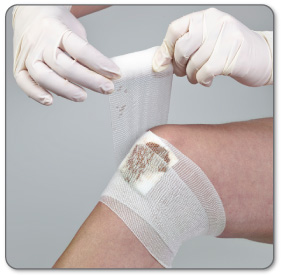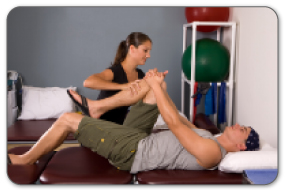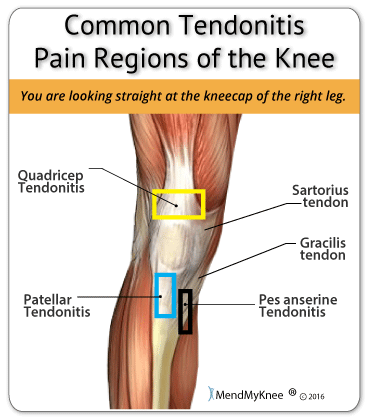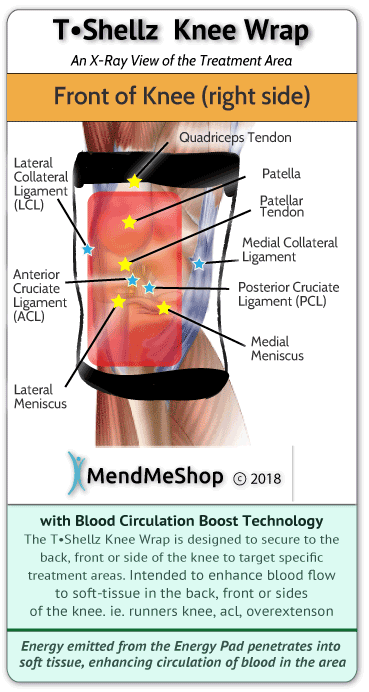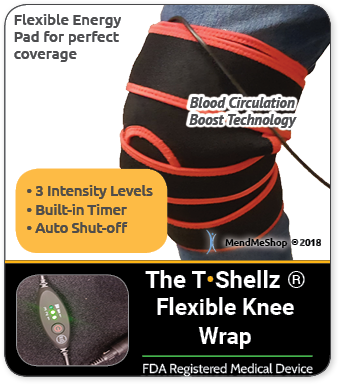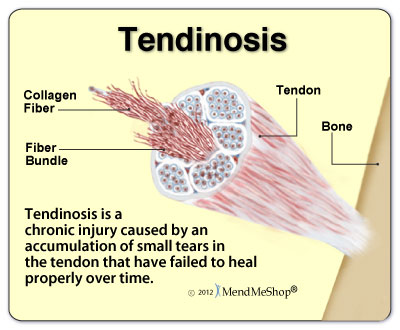Meniscus Treatments at Home
The good news is that most minor meniscus injuries will heal with simple home conservative treatments and surgery is often not needed.
Some small meniscus tears have no symptoms at all and may disappear on their own. Other less severe or non-complex tears will subside with conservative treatments, especially if your knee is stable and doesn't lock. These tears are often located on the outer edges of your meniscus.
It is the blood in your body that heals and repairs damage to your tissue. By transporting oxygen and nutrients to the area and flushing away dead tissue, your blood helps your body to heal itself. Unfortunately, when a meniscus injury occurs and you have knee pain, you need to prevent further injury and rest the area to allow it to heal. By resting, you actually limit the flow of blood and this slows down the healing process. The trick to healing a meniscus tear (as long as the tear is in a zone that gets blood flow) is to slow tissue damage, reduce scar tissue, and generate blood flow to speed healing and prevent further damage.
If you suspect you may have a medial meniscus tear injury..
- The first thing to do is speak with your doctor. Only your doctor can give you a proper diagnosis and from this, determine a course of proper treatment. Unless you need surgery to fix your torn medial meniscus, your doctor will almost always recommend conservative treatment options - conservative treatment options for a medial meniscus tear typically means rest, ice the injury, elevate the injury and take anti-inflammatory medication.
- Second, if your doctor has decided that your injury can be treated with conservative treatment options, then you'll find that many of our customers have had great success treating themselves with our powerful home conservative treatment device - the Knee TShellz Wrap®.
- If surgical intervention is required, talk with your doctor about using the TShellz Wrap® for post-surgery recovery as you will find it highly effective for enhancing range of motion, stimulating an increase in blood flow and minimizing scar tissue growth.
Injections
In most cases, your Doctor will start with non-surgical treatments options. Some of the options your doctor may recommend include anti-inflammatory medication to manage pain and inflammation. Steroid injections are advised with caution for any type of tendon condition as there is increased risk of tendon rupture.
(reference: American Academy of Orthopaedic Surgeons)
Restricted Movement Is Risky If It Goes On For Too Long
There are risks associated with regular use of a knee brace, especially if the brace you are using is not a custom fitted/design. If you are using a standard or "off the shelf" knee brace then it is possible that the brace is not the right size, positioned incorrectly on your knee, or even causing more damage to your injury. Knee braces can also feel heavy or bulky at first if you are not used to wearing one. It is possible that you may not feel the benefits of wearing a knee brace for a month, or however long it takes for you to feel comfortable wearing your brace. Skin irritation can also occur under the brace depending on the breath-ability of the material you are using for your knee brace and the overall fit. One important thing to be aware of is the amount of restriction you are placing on your knee while wearing a knee brace. Too much restriction in movement for an extended period of time can result in stiffness of your joint, chronic pain, or wasting away of the ligaments, tendons and muscles in your knee and leg.
Before we go further, it's important to understand that your body is capable of healing itself - though it requires the flow of blood to do so. When it comes to meniscus injuries, the inner third of the meniscus (known as "the white zone") really gets little to no blood flow and if you have a meniscus tear in this area, your physician will probably recommend surgery to fix it. This is one of many reasons why you need to see a doctor - only they will know if the tear is "surgically necessary" (SN). A physician will always try to opt for the conservative treatment first - usually, it works although it takes time to heal. If your meniscus tear is outside the white zone, then, with good blood flow in the area, the damaged fibrocartilage will receive oxygen and much needed nutrients while flushing away toxins and waste - otherwise known as healing. Inflammation and reduced movement (lack of activity or on-going immobility) reduces the flow of blood to an area that's already receiving very little blood flow which is why it is important to keep it down. If you are still active with a meniscus tear, you run a risk of increasing the severity of the injury; if there has been some healing, you could re-injure your meniscus all over again and/or easily make it worse.
Blood Flow - the natural healing process in your body - needs assistance for medial meniscus injuries because blood flow is greatly reduced when you're injured. When treating a medial meniscus injury or really any type of meniscus or knee injury (ie. lateral meniscus tear, bucket-handle tear, posterior horn tear, or anterior horn tear), you need to increase blood flow to your injury while your knee is healing. This increase in blood flow will accelerate your body's own ability to heal itself. We believe the Knee TShellz Wrap® is the most highly effective blood flow stimulation device that is registered with the FDA and available for home use.
If you have a medial meniscus injury, it's very important to heal it quickly and completely. Minimizing the healing time should be an obvious goal, as a chronic medial meniscus tear will limit your ability to go about your daily routine for a long period of time.
A seemingly small, nagging injury in your meniscus that's not properly treated can lead to a chronic painful degenerative medial meniscus tear that can persist for years if not properly treated.
Home Remedies via Conservative Treatments for Meniscus Injuries
Meniscus surgery is the most commonly performed orthopedic surgery in the United States1. One major reason for this is that the meniscus is very important; knowing the heavy correlation between meniscus deficiency and osteoarthritis, doctors are doing everything they can to try and repair a meniscus instead of removing it. Doctors and surgeons know that meniscus surgery will introduce more scar tissue into the knee - this is why they only recommend surgery as a last resort. This added scar tissue will be problematic, requiring physical therapy and conservative treatment options post-surgery. If you receive good news from your doctor, he or she will predict that your meniscus can be successfully healed through the use of conservative treatment therapies - without resorting to knee surgery. If you have been given news that you're going to need surgery, once surgery is complete your doctor will once again start you on home conservative therapies. Talk to your doctor about when you can incorporating the Knee TShellz Wrap® into your home treatment plan during your post surgery recovery.
If you have undergone surgery, we highly recommend you go to our Meniscus Post-Surgery page and learn more about post-surgery rehab.
Some conservative treatment methods recommended include:
- Rest - This is important for initial recovery; rest and elevation will help reduce pain, swelling and inflammation in the early stages of injury. This can be difficult when you have to carry on with daily activities, but resting and elevating your knee whenever you can is recommended. During your recovery you will probably have to modify or avoid the activities that put stress on your knee until your pain and inflammation settles. However, too much rest can also be harmful, as knee and ankle immobility can actually cause stiffening in the joints. This is why rest should be used when reducing initial pain and swelling, but should not be considered for more long-term conservative treatment.
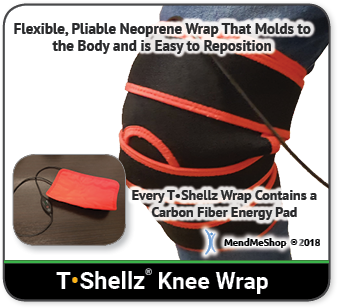 - Avoid Activities that Caused Your Knee Injury - While resting your injury it's also important to avoid all activities that may have caused your knee damage (especially any strenuous or repetitive movement). Continuing on with regular activities can increase the severity of your injury, turning a mild to moderate case of tissue damage into a downward spiral that can often severely impact your life. Also, trying to 'work around' your injury will eventually give rise to over-compensation injuries in other areas of your body.
- Use a Cold Compress or Ice Pack - Cold is very effective at reducing pain and inflammation - use at the onset of the injury and during flareups.
- Use a Knee TShellz Wrap® - Once swelling has been reduced, you can use your own blood flow to maximize your rehabilitation. Improved blood flow to your knee in most cases will help improve recovery time while improving overall health of soft tissue in the area. Knowing the body uses blood flow to heal soft tissue, this wrap is intended to maximize your rehabilitation by maintaining a healthy blood flow to soft tissue. Increased blood flow to damaged soft tissue should augment the bodys' own repair process, helping decrease recovery time while reducing re-injury risk. Promoting blood flow and heat to the treatment area will help to minimize the growth of scar tissue, increase tissue flexibility and help reduce onset of atrophy. This is why we recommend a TShellz Wrap treatment before undergoing activity - an increase in flexibility should help reduce risk of further injury while also assisting in the battle against atrophy. Heat via the TShellz Wrap® is especially helpful in dealing with chronic tendon & muscle injuries or on-going pain and stiffness from a strained knee.
- Use a Knee Support & Compression Sleeve - If you are experiencing discomfort or a feeling of knee instability, the MendMeShop Knee Sleeve is designed to help. The compression sleeve will move easily with your body with no stiffness in the sleeve itself despite being compression apparel. The sleeve is designed not to chafe the skin and reduce stiffness, swelling, and inflammation in the joint.
- For reducing discomfort while resting, (or to get some sleep) consider a High Quality Back Pillow and/or Knee Pillow for comfort while sleeping or sitting
- Try to Avoid Over Compensating for your Injury on your "'Healthy' (Non-Injured) Side - Many people will start limping or carrying objects with their opposite arm to compensate for their leg injury. Our bodies can adapt easily to any changes, including a hamstring injury. This quick adaptation could mean that you are already compensating for your injury without even knowing it!
When you compensate for your injury by using your opposite ('healthy') arm, leg, shoulder, knee, foot, etc. - then you are putting more weight and pressure on that side of your body. In many cases, your dominant side was injured (if you're right-handed this would be your right side) so your weaker side is trying to pick up the slack! The pain, stiffness, swelling and inflammation you then get on your 'healthy' side is something referred to as 'over-compensation pain'. Over-compensating for your injury can lead to other injuries and as such, it is important to be aware of how you are compensating so you can be extra careful; if there is an overcompensation flareup, treat this with the same conservative treatment methods to keep in under control.
- Rehabilitative Stretching under supervision of a PT or doctor. The intent of this is to provide you with increased range of motion, pain relief and strengthening of the surrounding tissue of the joint. Doctors or surgeons typically won't perform a surgery until they feel that their patient has put effort into treating their injury with conservative treatment methods. This may include up to 4 to 6 months of visits to a PT clinic. If you haven't experienced any improvement in your condition during that time then surgery may be considered. Agressive PT approaches may focus on forced or manual manipulation of the leg/knee - this means your physical therapists will be trying to move your knee past the point of comfort as they strive to increase range of motion and prevent further atrophy. This can be painful and end up making your injury worse if not done correctly. (reference: 1)
- Stretching - Stretching your joint in PT and at home will help you to regain your range of motion much faster than not stretching at all. Stretching in many ways is key maintaining good Range of Motion (ROM) in your joint, and stretching can be made much easier with use of a TShellz Wrap® before to warm up soft tissue, and a Cold Compress or Ice Pack treatment after to prevent any return of swelling and inflammation.
Meniscus Tear Home Conservative Treatment Options
Step 1 - Reduce Pain and Swelling with Cold Compression
The first step for conservative treatment of a meniscus tear is to reduce the swelling in the knee to "open up" the area for more blood flow. Anyone in the health-care business knows that your blood supplies the oxygen and much needed nutrients required to heal soft tissue tears. This is why for years, doctors, trainers, and other medical professionals have recommended RICE (Rest, Ice, Compression, Elevation) to treat the pain and swelling of fresh injuries, chronic pain, re-injuries and overcompensation strains.
This is important because once blood vessels are blocked or damaged, they can no longer carry oxygenated blood to your damaged tissue so this tissue begins to break-down. Without cold therapytissue damage and break-down continue as they cannot get the oxygen they need to survive By limiting the amount of damage done to the meniscus (and other soft tissue in the knee), you also limit the amount of healing that needs to occur. Arresting the damage (preventing the injury from worsening), is an extremely important step to get quickly on the path heal both acute or chronic knee injuries faster and with less pain.
Use a Cold Compress or Ice Pack:
- 24 to 72 hours after your initial injury or when you first notice pain and swelling in your knee to stop tissue damage, relieve pain, and decrease swelling.
- After exercise, workouts or activity of any kind to prevent re-injury of your knee.
- Before and after surgery during rehabilitation to control pre and post-surgery pain and swelling.
- Anytime you feel your knee is painful or you're having a flare-up of an old injury.
- Anytime you have swelling, sharp throbbing pain or inflammation in your knee.
- Any other situation where you need to draw the pain and inflammation out of your knee.
Step 2 - Improve Circulation, Soften Scar Tissue & Prevent Re-Injury with a TShellz Wrap®
Quite a few people think their meniscus is healed after their swelling and inflammation are gone and their knee feels better. They also make the mistake of returning to regular activities too soon without proper time for healing. The truth is that healing takes time and after the swelling is gone, your meniscus injury isn't even close to being fully healed. Proper healing takes time - especially when it comes to cartilage, and quite often meniscal damage can persist without the presence of pain or swelling.
After the inflammation in and around your knee has been reduced, providing extra blood flow to the meniscus (and other soft tissue in the knee joint) is recommended; this added blood flow increases the transport of oxygen and nutrients to the damaged soft tissue - accelerating the healing process. We created a term for this - we call it Circulatory Boost. It should also be stated that at this time (when swelling and inflammation is gone and your body is trying to heal the damage) it is imperative for you to focus on avoiding re-injury and strengthening the weakened tissue in your knee. It is vital that you don't go back to activities too soon because you can easily bring about a major setback in your recovery...
- Have you recently re-injured your meniscus by returning to your normal daily activities too quickly?
- How many times in the past have you aggravated your knee just trying to perform basic tasks around your house?
- Is your torn meniscus preventing you from work or activities you love to do?
If this sounds like you - You're not alone...
Most people we deal with tell us these scenarios have happened to them many times in the past. The real challenge is how to promote blood flow to your injured meniscus without causing further damage. This goal is even more complicated by the fact that you have to use your knee for nearly everything in your active life.
What can you do to actually start healing your meniscus?
The answer is simple. Your body can heal itself and it's the blood in your body that makes it all happen. Your blood is how everything that's good inside of you is transported directly to your injured meniscus tissue. Your blood carries oxygen, nutrients and water right to the source of your injury and pain. Bringing proper blood flow to your injured meniscus is essential to healing.
Promoting blood flow around injured tissue to help the body heal itself is a concept that's been used for centuries. Oxygen and nutrients, carried in your own blood, are critical for the body to heal itself. Without adequate blood flow, recovering from your meniscus injury will be slow... sometimes so slow that it cannot keep up with natural degeneration over time.
Even though the concept is simple, getting more blood flow to a meniscal injury is often harder than it seems. Traditional methods require you to move your sore/stiff knee in order to promote blood flow, but this same motion that promotes blood flow can also make your pain and meniscus injury much worse (especially if you need to immobilize your knee during surgery recovery). Relying on movement alone to increase blood flow puts you in danger of re-injuring your meniscus.
So what do you do when you need to increase blood flow, but you can't move your knee without re-injuring your meniscus?
This is where the Knee TShellz® Circulatory Boost Wrap comes in
Regular treatments with a Knee TShellz Wrap® will increase blood circulation in the area, reduce pain and stiffness and increase overall flexibility in the area of application (yes, the knee - or anywhere you put it). Increased blood flow will whisk away damaged tissue, toxins, and any bacteria in or around your injured meniscus to promote more effective healing. Getting rid of toxins will allow all of the positive healing processes to start in your injury. Increasing blood flow will also increase the amount of oxygen that's being sent to your injured tissue AND boost your tissue's ability to absorb oxygen. (reference: link)
Remember, the meniscus is cartilage and does not receive much blood flow naturally. When you rest your knee, you are not creating the natural blood flow your knee usually receives. With the use of a TShellz Wrap® you can increase your body's blood supply to the knee to assist the body in its recovery process.
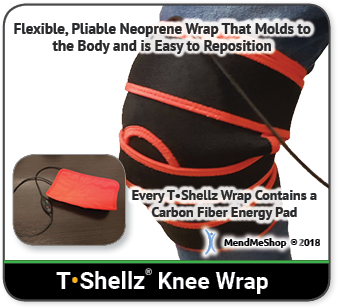
- When treating any soft tissue injury, an effective treatment will increase blood flow to the injury while the joint is immobile.
- This increase in blood flow will help maximize the body's own capability to heal itself.
A Recap of the Benefits of the Knee TShellz Wrap®..
- Our Knee TShellz Wraps® can fit ANYWHERE on the knee - side, back and front.
- It can be used before activity or exercise to warm up tissue in the knee to reduce the risk of further injury
- FDA Registered medical device for use in home or clinics - very high quality
- Temporarily increases flexibility and length of soft tissue (reducing the re-injury factor)
- It soothes pain and whisks away toxins
- Carbon fiber Energy Pad is strong, lightweight, and flexible - contours very easily
- A boost in blood flow helps maximize the body's ability to recover from soft tissue damage. This can be beneficial in saving time and money when associated with doctor or physio visits
- A boost in blood flow will maximize the body's ability to recover quickly. This can be beneficial in post-surgery rehabilitation, getting you back to work faster. Do not use until at least 6 weeks after surgery, and only after approval from your doctor.
Keeping your knee as healthy and strong as possible throughout the healing process will allow you to get back to your regular activities faster. The Knee TShellz Wrap®, available exclusively from MendMeShop®, provides effective, non-invasive, non-addictive pain relief and healing with no side effects.
The benefits of TShellz Wrap® do not end once your knee pain stops! Even once your meniscus troubles are mostly behind you, your activities can put your knee at risk of an overuse injury, tightness, or another tear. A TShellz Wrap® treatment before activity is an easy way to warm up the knee tissues and prepare them for use. Then, end your day with another treatment to prevent tightness from setting in overnight. This incredible healing tool will be the ticket to healthy knees for years to come!
During your recovery, you will probably have to modify and/or eliminate any activities that cause pain or discomfort in your knee area until your pain and inflammation settle. With these therapies you will notice great improvement within a few weeks, with most meniscus patients seeing some improvement quickly. The more diligent you are with your treatment and rehabilitation, the faster you will see successful results. If you start using your knee before it has a chance to heal properly (even though it may feel better), you can end up doing a lot more damage than good!
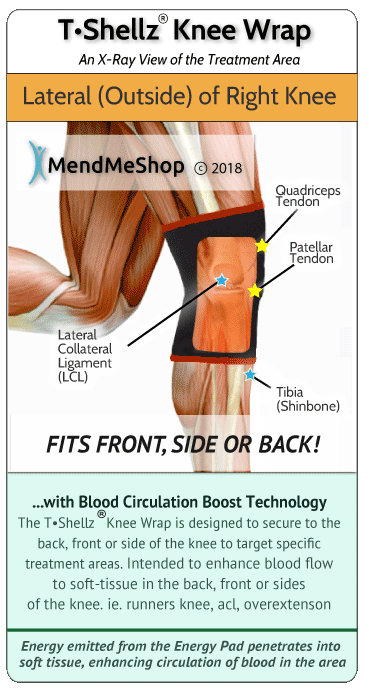
When Should I Use My TShellz Wrap® During the Day?
The most common question we receive from individuals prior to purchasing is - how many times a day should I be using my wrap and when should I be using them? While treatment plans will differ for each individual and their specific injury, there are general guidelines that should be adhered to.
- Use a Cold Compress or Ice Pack when you are experiencing inflammation (usually after exertion or movement of the injury area).
The TShellz Wrap® would then be used:
- Right after rising from bed in the morning (as this is when your knee is often stiff)
- Prior to going to bed at night (to relax the area and allow for better sleep)
- Before you know you will be using your injured joint (going to work, driving, typing, etc).
Use a Circulatory Boost Knee TShellz Wrap®:
- After swelling and inflammation have been reduced with cold compression.
- Before exercise or workouts to warm up your knee to reduce your risk of re-injury.
- Before and after surgery during rehabilitation to warm up soft tissue in your knee before physical therapy, exercising or stretching.
- Anytime you feel the tissue in your knee has stiffened up, is tight and your mobility is reduced causing you more pain.
- Any other situation where you need to increase blood flow to your knee to relax your soft tissue, relieve pain, prevent re-injury and enhance flexibility of your tissue.

Increased Blood Flow = More Oxygen, More Nutrients and Less Toxins = Healthier Tissue
We believe the use of TShellz Wraps® for boosting blood flow in the area of application is one of the most under-utilized home treatment options available on the market today. We have client after client that have tried many options out there and have been amazed at how effective and fast the TShellz Wrap treatment can relieve pain and increase localized blood flow in the treatment area.
The TShellz Wraps significantly increase bloodflow to tissue in the treatment area - period. With regular use of the
Knee TShellz Wrap:
- Your pain will be reduced*.
- With increased blood flow, tissue in the area will recover at an accelerated rate*.
- Due to increased warmth in soft tissue, the corresponding joint will have a larger range of motion and increased extensibility of collagen tissue*. This should translate into a reduced rate of injury occurrance as soft tissue becomes more flexible.
(*Chapter 9 of "Therapeutic Heat and Cold", 4th edition.
(amazon.com link - Ed. Justus F. Lehmann, M.D., Williams, and Wilkin)
Attach the TShellz Wrap® around your leg, plug it in and let the Energy Pad do the work!
*Know that every personal soft tissue injury is unique and the TShellz Wrap may not work for everyone. This is why we offer a 60-day full money back return on all our TShellz Wrap devices.
Stage 3 - In Between Treatments With TShellz Wrap®, Apply Our New Fast Acting Pain Relief Cream Called ARNICA INFUSION
Dealing with aches and pains affecting the foot, ankle, leg, knee, hamstring, hip, back, arm, shoulder, elbow, wrist, or hand? If so, then applying the Arnica Infusion to any of these targeted areas will bring about fast relief from the pain and sore tissues. Simply apply a small amount of cream to the body and moments later, you will experience a soothing and comforting sensation over the area.
Arnica Infusion is specially designed to relieve pain due to sore muscles and joints associated with arthritis, backaches, sprains, strains, and bruises. No matter if you are dealing with an acute injury, chronic pain, or a general "flare-up" - you will experience fast relief from pain and inflammation.
This is a product that many of our current MendMeShop customers asked us to develop. So we focused our time and resources over the past few years and came up, with we believe, will be one of more effective, fast acting, topical pain relief creams on the market.
You are likely familiar with some of the standard topical agents on the market as most of our customers use them. The are mass marketed and even found in most department stores now.
Well, we are here to say that Arnica Infusion goes many steps beyond what they offer.
Made in the USA at an FDA registered manufacturing facility, you can be assured that Arnica Infusion is both safe and effective. We only source top grade ingredients while implementing strict quality control checks during every step of the production process. Expect the same high quality that MendMeShop customers have been accustomed to since we started the company in 2005.
The "Cool Blue" formula is the perfect balance between the smooth application of a cream and the effective absorbing factor of a gel. It is not too thick and not too thin - just the right texture. Best of all, it feels very nice on the skin!
Each application of Arnica Infusion feels so comforting and soothing, we are certain it will become an item you will not want to live without.
Arnica Infusion Ingredients
The Arnica Infusion formula is based on a combination of scientific research and the use of high quality ingredients. The properties within the formula were chosen for their pain relief, anti-inflammatory, and soothing qualities.
The acting ingredients within the formula include ones many of us are familiar with; along with ones that have not received a lot of publicity (only in research circles). Extensive testing resulted in a blending of ingredients that provides the most synergistic of benefits.
The notable ingredients in the Arnica Infusion formula include:
- Arnica - powerful anti-inflammatory, speeds recovery, enhances circulation
- Menthol - provides deep penetrating pain relief with a nice cooling sensation
- Vitamin B6 - promotes normal nerve function
- MSM - supports healthy connective tissues, anti-inflammatory
- Ilex Leaf Extract - increases circulation, skin conditioner
- Vitamin E - anti-inflammatory, enhances circulation, hydrates the skin
- Aloe - anti-inflammatory properties, soothes the skin
- Tea Tree - enhances penetration of ingredients
Extensive quality control procedures during the manufacturing process ensure the ingredients and final product are both safe and effective. We would not stake our reputation on anything but the best.
When Do I Apply the Arnica Infusion?
While At Work
Apply Arnica Infusion at work to help reduce acute discomfort associated with overuse of muscles and joints. No matter if you are in a physical demanding job or work within an office environment, you will be placing stress on different parts of the body and aches and pains will result.
Before Or After Work, Sports, & Activity
If you suffer from a sprained ligament, pulled muscle, strained tendon, or even bruising - apply Arnica Infusion for quick relief of the pain.
Chronic Pain Suffering
Application of Arnica Infusion can be done up to a maximum of 4 times per day on a consistent basis to help bring about relief from various pains and aches.
In-between Treatments With the TShellz Wraps®
Follow up your T-Shellz and Cold treatments with an application of Arnica Infusion. Combine the pain relieving benefits of Arnica Infusion along with the healing benefits of the wraps to make your recovery go much more smoothly.
Do not apply Arnica Infusion within a 2 hour timespan before a TShellz Wrap® treatment.
Whether you decide to use the Arnica Infusion in conjunction with the TShellz Wrap® and other treatments - or if you decide to use the cream as a stand-alone product - you will not be disappointed with the results. We guarantee it.
Step 4: Physio (PT)
Visiting at a PT clinic is a beneficial way to help decrease pain in soft tissue, restore atrophied muscles and improve knee and leg strength and mobility. The type of PT and the duration will be dependent on the extent of your meniscus injury.
Gentle massage around the injured knee area or small flexing or extending knee movements (if not painful) will also help increase blood flow, oxygen, nutrients, and will prevent stiffness.
Once your pain starts to diminish, a physiotherapist will set up an individualized knee and leg strengthening and stretching exercise program for you to perform at home or in the gym. This will be based on your needs and abilities, and will help you return to performing your normal routines. Individuals will often exercise or lift weights on their own to try and build up their strength; however in doing so, they can do more damage. It is extremely important to strengthen your muscles properly, as they may have weakened during the period of non-use. A trained therapist will help to ensure your rehabilitation process is effective. For best, long-term results use physical therapy along with an exercise program.
There are also alternative forms of physical therapy geared to your lifestyle, condition and/or if you have had a surgical procedure done. Some common forms of physical therapy include:
Active Physical Therapy - Stretching, range of motion, strengthening and pain-relief exercises specifically intended to improve the function of your knee. It is common, when suffering a meniscus injury, for physical therapists to also recommend exercises for your hamstring and quadriceps muscles. Your physical therapist is hoping that strengthening these areas will reduce the amount of weight placed on your knee and increase the level of assistance the rest of your leg gives your knee during movement.
Passive Physical Therapy - Treating pain, swelling or increase circulation before and/or after active physical therapy. Some passive physical therapy techniques your physical therapist will use include massage or manual manipulation, temperature therapy (warming or cooling of your tissue) or use of clinical devices such as an electrical stimulator or transcutaneous electrical nerve stimulation (TENS) or Therapeutic Ultrasound.
Post-Surgical Rehabilitation - After your meniscus surgery, your orthopaedic surgeon and a physical therapist will provide you with a specific treatment plan for your rehabilitation. This will consist of a time-line detailing conservative treatments intended to relieve pain and stimulate healing, as well as specific physical therapy milestones for strengthening your knee and regaining full movement.
Aquatic physical therapy provides the same benefits of regular physical therapy, and focuses on improving knee function, endurance and flexibility as well as overall balance, coordination, posture, and muscle strength. This type of physical therapy provides exercise and training in a pool setting that reduces the amount of weight placed on your knee while creating resistance for simple movement.
Athletic or sports therapy is geared toward sports-related injuries, especially if you are an athlete of any kind and wish to return to your sport or athletic training as soon as possible after injury or surgery. Therapy of this kind can be explored both before and after surgery, or can be used to avoid surgery altogether. With these treatments, a physical or athletic therapist will take you through full rehabilitation by designing a program that will focus on increasing strength, endurance and agility specific to the sport that you play. Exercise and stretching regimen may be accelerated to return you to sport sooner, and some drills may be created to ease your body back into athletic performance.
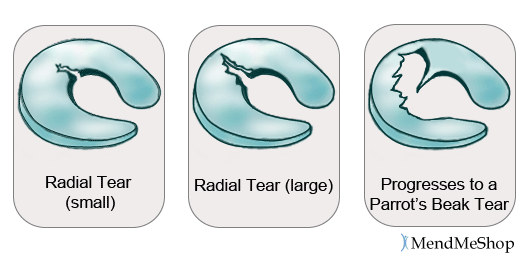
Occupational Therapy - There are many forms of occupational therapy, but these treatments generally consist of focused therapy meant to gradually return you to your normal, daily living conditions. In most cases, this means creating a transitional period during your rehabilitation so you may return to your work or job. This is definitely the case if your knee injury has occurred through an acute or chronic event related to your occupation. For this type of therapy your physical or occupational therapist will provide exercises and activities that will prepare you for the activity of your job (if it is physically demanding). Your therapist may even assess your work environment to make sure you are using proper equipment and your working conditions are conducive of your knee healing completely and preventing re-injury.
Step 5: Passive Knee Stretching...
an Essential Tool for Complete Knee Injury Recovery
If you have a significant meniscus injury you may undergo surgery or the doctor may prescribe a course of conservative treatments if he/she feels it can heal without surgery. Either way, your doctor or physical therapist will most likely want to to keep much of your weight off your knee and recommend the use of crutches. Within a course of conservative treatments, they will also prescribe gentle stretching of an injured knee. They don't prescribe this to annoy you - it is in fact the most important part of knee injury recovery. You probably know of someone that chose not to do these stretches as it is common - and they paid a high price for it. By not listening to the therapist (ie. not stretching), there is a huge chance of re-injuring your knee or even sustaining an injury greater than the original injury ever was.
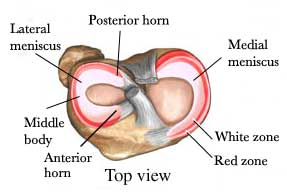 One of the most important tasks you will be required to complete by our doctor or physical therapist is stretching your knee after injury. 'Working' the tissue, strengthen the tendons, ligaments but the key ingredient is increasing blood flow to the area. The meniscus is a very blood starved area and exercising the area will allow extra blood flow into the tissue. The new flush of blood also helps clear away any dead tissue and waste inside the joint.
Scar tissue develops as part of the healing process. Even when you're injured and in pain you need to keep moving to break-up scar tissue. Regular movement can increase healthy range of motion (ROM) of your knee, guaranteeing you a speedier recovery process and return to regular activities. Moving when you're injured is hard. Since moving while injured can be painful most people think it's better to stop moving, rest their knee and hope that their knee injury will heal all on its' own. Even though rest is important to recovery, too much rest during the recovery process will increase the amount of scar tissue in your knee.
During the healing process your body will fill in tears in your knee with dense, brittle tissue called "scar tissue". The human body will use scar tissue as a temporary solution and will try to build the scar tissue as fast as possible to patch tears together. Scar tissue can form fast to bring together the edges of a tear, but working fast doesn't mean that the job's done right. When scar tissue forms it doesn't come together as neatly as regular (healthy) collagen does. Scar tissue fibers will lay down over top of your tear in a cluttered, messy and jumbled up way.
>Imagine throwing a bunch of toothpicks in the air... When they hit the ground they will land in a random, unorganized way. It even seems silly to think that they could land perfectly straight and all in the same direction. This is how scar tissue works - the scar tissue that forms in a tear will be unorganized and won't line up properly with the healthy tissue surrounding the tear. This scar tissue will also attach to everything in and around your knee injury including the surrounding healthy tissue as well. This can result in a long-term fusing together of your ligaments, muscles and tendons; it is this fusing of scar tissue that stiffens your knee, reducing mobility and making the injury even more painful when you move. Using a good passive knee stretching routine at home - every day - will help you heal and ensure your tissue is strong and healthy!
An untreated Meniscus injury leads to degenerative changes in the knee! 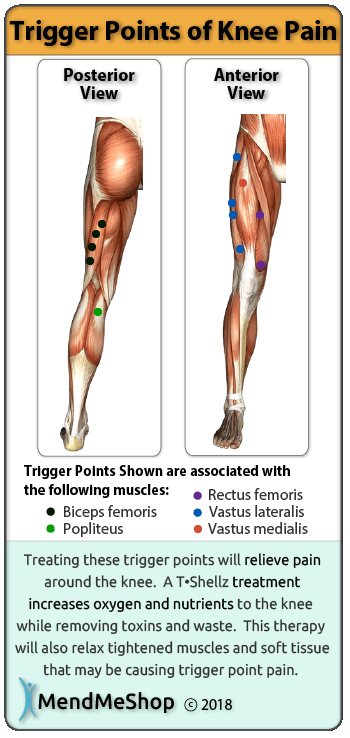 A complete removal of the meniscus via surgery will change the way your knee functions - this can also occur in partial meniscus removals if the portion is substantial . What has been shown in numerous studies is that when a meniscus is removed (fully or partially) , it is nearly 100% guaranteed that you sooner or later suffer from osteoarthritis in the knee. Osteoarthritis in the knee means that articular cartilage (the smooth cartilage covering the ends of the bones that meet in the knee joint) wears and breaks down, exposing bone and eventually leading to bone wear and breakdown as well. The simple task of using passive knee stretching on a daily basis will retain knee strength and flexibility, helping slow the onset of osteoarthritis (and other degenerative knee conditions). Passive knee stretching has been shown to decrease rheumatoid arthritis pain and slow down the rate of joint degeneration (source Scandinavian Journal of Rheumatology)
Inflammatory response diseases such as rheumatoid arthritis have been known to leave you with 'morning stiffness'. The constant build-up of inflammation in the tissue and joint blocks the cells with waste matter. Your are left with weakened muscles and the feeling of an unstable joint with your knee and leg feeling 'drained of energy'. By simply increasing the elasticity of soft tissue in the knee via passive stretching, you can change the over-all health of your knee joint. Stretching soft tissue in the knee on daily basis increases blood flow, helping flush out the toxins inside the knee joint; this results in reduced knee pain. (source US National Library of Medicine)
As you slowly start implementing passive knee stretches, you should find that your knee recovery will accelerate as well. The increased joint flexing will help your knee connective tissue to regain elasticity; the stretching movements in the knee joint will increase blood flow to the recovering injury, further aiding in the healing process. Passive stretching is what lies between bedridden immobility and crutches. Using crutches too quickly can be detrimental to your recovering knee, as many patients can certainly attest. A quick slip on the crutch can easily result in your bad knee bearing your full body weight, often causing a worse re-injury or perhaps a fall.
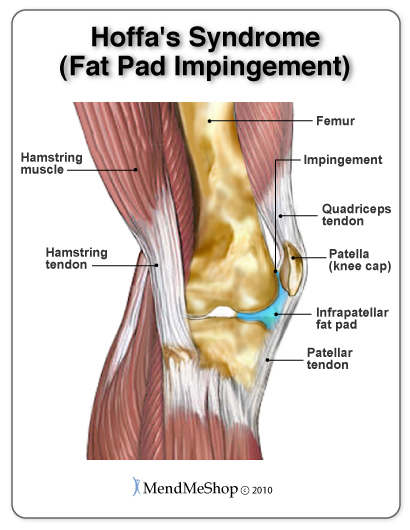 Incorporating passive knee stretches into your treatment routine (when your physician or physical therapists says you are ready to do so) not only helps minimize the growth of scar tissue, but it also increases the elasticity and strength of the joint. After utilizing passive knee stretches over time, your knee joint will be better prepared to handle higher and higher loads. Eventually you will reach a stage where your knee joint can handle crutches or standing for longer and longer period of time. This is the final stage of recovery and depending on age, the nature of the injury, your weight and many other factors, it can take the longest time to complete. But remember, for knee injuries, it pays to be patient! Rushing your knee injury recovery almost never pays.
We Guarantee That If You Use Our Products on Your Meniscus for 60 days as Directed, Your Pain Will be Greatly Reduced or Eliminated and Your Joint Flexibility will Increase. If This Does Not Happen, We Will Refund Your Money.
We are an FDA Registered Company, and our TShellz Wrap, also known as a Circulatory Boost Wrap, is an FDA Registered Medical Device suitable for use in hospitals and therapeutic clinics. Since it is deemed safe for patients to use themselves, the TShellz Wrap can be used for home treatment.
A Note On OverCompensation
Since you are reading this, you probably know that serious meniscus injuries do not just disappear. Over time, they usually wreak havoc on other joints in the body due to lack of movement and over-compensation. Recovery takes a longer time for such chronic (long term) injuries, but proper healing is essential to regain strength and get you back to the activities you enjoy.
The longer your injury endures, the greater the risk of running into serious overcompensation injuries.
To Stop Re-Injury & Reduce the Risk of a More Serious Overcompensation Injury, You Need to Heal Quickly & Completely!
Anyone in need of rapid recovery and complete healing must consider a comprehensive treatment plan that includes an effective means to minimize swelling and inflammation yet also stimulate healing and tissue elasticity. We have found no better set of tools that can be used at home than this:
Conservative Treatment Tools Our Clients Have Used to Help Limit Damage & Boost The Body's Soft Tissue Repair Process to the Knee at Home:
- A Cold Compress or Ice Pack to reduce inflammation wherever there is pain and/or swelling (as soon as possible).
- A Knee TShellz Wrap to increase blood-flow to the knee area (a Localized Enhanced Circulatory Response® Treatment).
- MendMeShop Arnica Pain Cream for temporary relief of pain due to sore muscles and joints.
- A High Quality Knee Pillow if you are experiencing discomfort when resting or trying to sleep (or you want .
- A Knee Compression Support Sleeve for light tendon/muscle support and risk reduction of further injury.
- An Exercise & Stretching Plan to prevent muscle atrophy and shortened tendons in the Knee joint. A proper plan will increase elasticity and strengthen the muscles and tendons in the hip, knee, and ankle.
Conservative treatment tools just like these have been used successfully by thousands of knee injury sufferers - just like you.
TShellz Wrap® = Enhanced Blood Flow in the Treatment Area
We believe the use of TShellz Wraps® for boosting blood flow to soft tissue in the area of application is one of the most under-utilized home treatment options available on the market today. We have client after client that have tried many options out there and have been amazed at how effective and fast the TShellz Wrap treatment helped relieve their pain while increasing blood flow in the knee.
With regular use of the Knee TShellz Wrap:
- Your pain will be reduced*.
- Due to increased blood flow, soft tissue in the treatment area on the knee will be expected to recover at an accelerated rate with reduced potential for re-injury*.
- Tissue in the treated area should experience a larger range of motion and increased extensibility of collagen tissue* due to the heat effect on soft tissue. This should translate into a reduced rate of re-injury occurrence as soft tissue is known to lengthen and become more flexible when exposed to warm temperature. (*Chapter 9 of "Therapeutic Heat and Cold", 4th edition.
(amazon.com link - Ed. Justus F. Lehmann, M.D., Williams, and Wilkin)
The Treatment Advantages just keep coming...
According to the trusted medical knowledge of Justus F. Lehmann, M.D. (well-known rehabilitation medicine specialist-amazon.com link), increasing the temperature of soft tissue through the application of a warming therapy will also provide these 7 Truly Amazing Benefits:
1. Increase The Flexibility of Tissue
Warming up soft tissue in the knee before stretching (at home or in a physical clinic) can provide on-going flexibility in your knee that will continue after the stretch is done. Experiments conducted by medical professionals have shown that applying warm temperature treatments (like the TShellz Wrap®) before stretching & range-of-motion exercises can provide lingering flexibility that is beneficial when stretching any of the soft tissue in your knee.
2. Decrease Joint Stiffness
Medical studies have shown a decrease in joint stiffness after the temperature of injured tissue is increased with a warming temperature therapy compared to the stiffness experienced at a much lower, normal, body temperature.
3. Relieve Muscle Spasms
Tissue and muscles that have been over-strained or injured can suffer from continuous squeezing in the muscle fibers... This is also known as a muscle spasm or trigger point pain. On-going muscle spasms will decrease blood flow and increase your nerves' sensitivity to pain.
It has been believed for a long time by many medical professionals that a tissue warming treatment can reduce the incidence of muscle spasms. It is generally accepted by the medical community that the body's response of increased blood circulation due to the introduction of heat will help alleviate spasming muscles.
4. Control and Reduce Pain
There are a lot of reasons why you may feel pain... You could be feeling pain from muscle spasms, lack of blood flow to your soft tissue, and even stress placed on your nerves due to overall stiffness in your knee or leg. Significant pain relief can be felt from introducing heat treatments. Increasing the temperature of muscle tissue in your knee can reduce pain sensation experienced in the base of the neck and upper back.
5. Increased Blood Flow
Using a tissue warming treatment will trigger the body to send increased blood flow in an attempt to "cool down" the area. This can produce an increased level of blood flow similar to the amount of blood flow achieved through regular exercise.
6. Relieve On-going Inflammation
Increased blood flow can take away any remaining built up fluid (edema) and lingering inflammation. This will help to decrease your pain and speed up the healing process.
7. Treat a Variety of Knee Soft Tissue Injuries
Warming temperature therapies like TShellz treatments are now becoming a leading edge home medical care solution for soft tissue injuries to promote both relief in chronic injuries (torn meniscus, osteoarthritis, bursitis, or ligament tears) and speed up the overall healing process for newer (acute) knee soft tissue injuries.
The Key Point To Keep in Mind When Treating Your Injury
Make Sure That Complete Healing is Your #1 Goal
We all know that if the injury was healed, the pain would go away but what about the opposite situation? If the pain is gone, does that mean the injury is better? Unfortunately, this is not always true.
Too many people only focus on suppressing pain symptoms while providing less attention to the true healing aspects of the body. Experiencing less pain, while obviously a good short-term goal, rarely equates to underlying healing. Scar tissue can remain for months after one gets to a point of being relatively pain-free. However, as long weak and brittle scar tissue remains, you are susceptible to re-injury or re-aggravation. Certain motions or movements can cause the weaker tissue to easily tear - resulting in some reversal of the recovery up until that point.
This is why we recommend for people to continue with their doctor or therapist recommended exercises and to continue with mild treatments of the TShellz Wrap® for a period of time - to better ensure complete healing.
Ongoing treatments to enhance circulation will soothe, relax and promote healing of your damaged muscles and tendons. T•Shellz treatments will also allow your soft tissue to extend further due to the increased heat generated in this same soft tissue. The more extensible your tissues are, the less likely they are to strain or sprain.
The Back TShellz Wrap® is a highly effective therapy tool for people suffering from knee problems - such as cartilage degeneration, ligament tears, knee strain, bursitis, tendinopathy, impingements, and any pain associated with trigger points, scar tissue, and arthritis in the knee joint.
Are you still unsure about placing an order? let me address some questions that may causing some hesitation...
How much time do I need to dedicate for treatments? Are the products easy to use?
The TShellz Wraps® are very easy devices to use. After one or two uses, you will engage in the treatments with ease. Very detailed instructions are included and you are always welcome to contact us by phone or email if the need for help arises.
In regards to the TShellz Wrap®, it is ideal to use the device two or three times a day on average. Recommended treatment times are 10 to 15 minutes in duration; the device will turn off after 30 as a safety measure. Typically, people use the TShellz Wrap® before bed, upon awakening (or not long after) and one other time during the day when the opportunity presents itself. For people in an office setting, many will use the device at work (as it can be worn over clothing). For others, they will use the device an our or two after work.
A Cold Compress or Ice Pack is primarily used following activity that stresses the injured tissues (following work, after a sports activity, or just suffering a general re-injury). This is done to reduce inflammation and to minimize tissue damage. Recommended treatment length is approximately 10 to 15 minutes in duration.
How long has MendMeShop been in business
We established our firm in December of 2005. Our track record in this field continues to grow and we plan on being around for many decades to come.
What is your return policy? Is it the standard 30 days?
We go above and beyond what other companies offer - we offer a full 60 day money back guarantee with no restocking fees.

AidMyMeniscus advisors do not work on commission, so be assured you will only receive fair and objective information.
We strongly believe that we can help you, and we have thousands of happy clients to back this claim. You are welcome to try our products for a 60 day period.. If you are committed to following the treatments outlined in the product instructions we are very confident that our TShellz Wraps will aid you immensely. If you do not receive the benefits that countless of our other customers have experienced from our products, call us, mail the product back to us and we will provide you with a full product refund.
![MendMeShop Pain Relief Products Guarantee]()
Our online shop accepts Visa & Mastercard as well as a Paypal Payment option.
We also encourage your to Call Our Office at 1-866-237-9608 (toll free continental NA) where we can answer any questions you have and/or take your order via phone.
Common Soft Tissue Injuries of the Knee
- knee pain
- ligament strains or partial tears (ACL, MCL, PCL, LCL)
- pain caused by knee overextension
- Hoffa's syndrome (fat pad impingement)
- meniscus tears within the vascular zone (the inner third of the meniscus is not in the vascular zone)
- chronic knee conditions
- strained muscles, spasms, cramps, tendinitis, tendinosis, tenosynovitis (quadriceps, patellar, ITBS)
- bursitis (prepatellar, pes anserinus, infrapatellar)
- chondromalacia, rheumatoid arthritis, osteoarthritis, articular cartilage degeneration : the Knee TShellz Wrap® cannot get rid of these chronic diseases but it will help alleviate the painful symptoms that can sometimes be debilitating.
Our customers love the quick, natural pain relief and you will too.
Find out more about the TShellz Wrap® by calling our Customer Advisers toll free within Continental North America at 1-866-237-9608, +1-705-445-3505 internationally, or email service@mendmeshop.com
Our TShellz Wraps® will assist you in recovering from your injury faster and reduce the chance of degenerative conditions introducing heat where it is needed most to reduce swelling and inflammation induced pain. You will be very surprised at the results you can achieve in a very short time, just by using this device at home every day as directed.
Continue the healing process by getting lots of rest and avoid overuse or loading on the knee. Limit movements that may aggravate your muscles, leading to re-injury. Without taking great care with regard to activity and rest, Injuries can easily turn from a mild grade 1 injury into a grade 2 or a grade 2 into a grade 3 injury.

Our online shop accepts Visa & Mastercard as well as a Paypal Payment option.
We also encourage your to Call Our Office at 1-866-237-9608 (toll free continental NA) where we can answer any questions you have and/or take your order via phone.
Product specialists are available 9:00 am to 5:00 pm Eastern Standard Time Monday to Friday. If any question or concern arises, call us or simply send us an email at any time (we check our emails constantly all throughout the day and night.. even on holidays!). We will respond as soon as possible. North America Toll Free 1-866-237-9608
Outside North America +1-705-532-1671
Learn More About Meniscus Injuries & TreatmentsI want to learn more about Post-Surgery Recovery I want to learn all about Types, Patterns, Shapes & Severity of Meniscus Tears I want to learn more about TShellz Wrap® Circulatory Boost I want to learn more about Ice & Heat: Which Is Better For Treatment? I want to learn more about Meniscus Treatments I want to learn more about different types of Meniscus Surgery
FREE SHIPPING ON ALL PRODUCTS CURRENTLY ENABLED
During your recovery, you will probably have to modify and/or eliminate any activities that cause pain or discomfort at the location of your soft tissue injury until the pain and inflammation settle. The more diligent you are with your treatment and rehabilitation, the faster you will see successful results!
| 